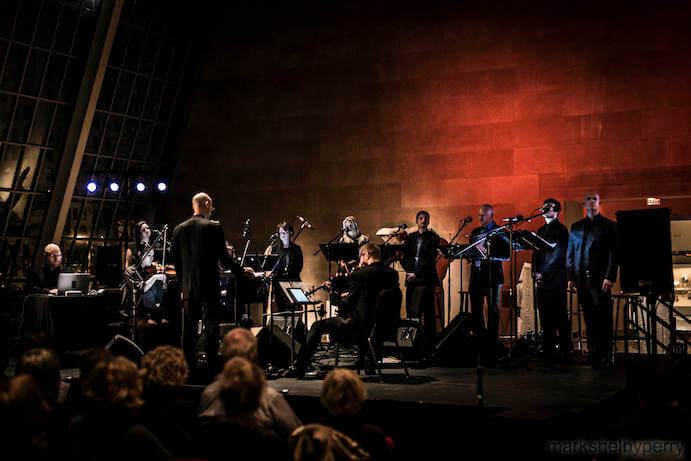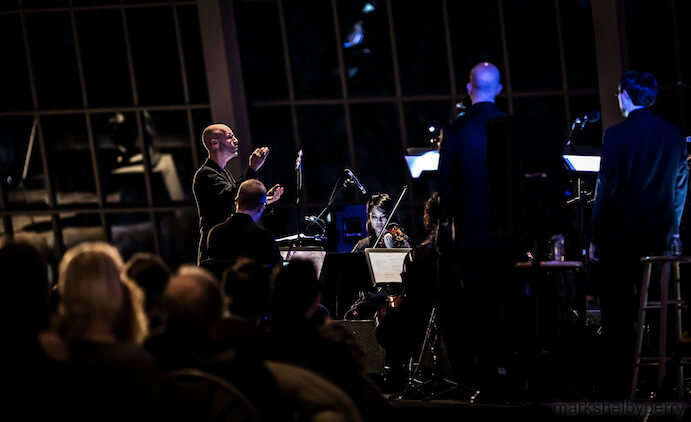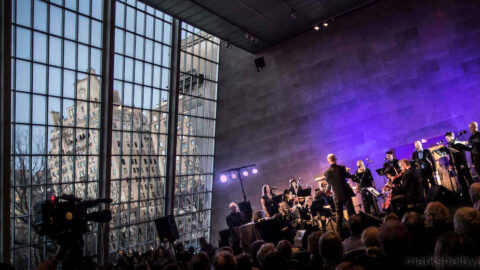The Metropolitan Museum’s Temple of Dendur exhibition space is an unlikely, compelling and acoustically difficult site for a concert. The cavernous room, with a wall of windows looking out on Central Park, houses a reconstructed Egyptian temple dating back to about 15 BC. The museum has been innovative in its programming for the room– from works by Estonian composer Arvo Pärt to indie rockers Interpol to the jazz precision of the Vijay Iyer Trio and the sludge doom of the post-metal band Om– while only sometimes overcoming the built-in sonic limitations.
A March 17 performance of two compositions by Icelandic composer Jóhann Jóhannsson didn’t suffer such shortcomings, if only for the textures of the work. The program opened with violinist Yuki Numata Resnick alone on stage working through the shifting and alternating patterns of Jóhannsson’s Chaconne. The piece held true to the baroque form it was named for, lines growing longer as Resnick played the variations softer and faster, then faster still and louder again, quiet arpeggios eventually returning to the original two notes with nice, natural room reverberation on the pizzicato. Allegro, adagio, forte, pianissimo, it was anything but the drone that would follow.

Lovely as it was, the Chaconne was just a prelude for the waves and layers that would follow. Drone Mass was performed by a double band of the chamber group ACME and the vocal ensemble Roomful of Teeth, used here as a chorus and not employing their full array of techniques adapted from cultures around the world. The voices were particularly effective against swooping string glissandi as the singers repeatedly held and released isolated tones.
The female singers of Roomful of Teeth started the piece, the men coming in below them before a slow string pulse set the process in motion. Slowly a thematic line emerged in the voices, almost unnoticed until a violin echoed it. The music swelled to fill the room quite wonderfully and ended all too soon, returning to the a cappella voices. The men initiated the next section, building to a smaller crescendo that was joined by electronics, chimes and white noise enveloping the voices. Sounds emerged that sounded like strings and drums, but weren’t. It was as if Roomful of Teeth and ACME had set forth the elements of a dense polyphony and then stepped back to let it happen without them– not as loudly as it might have, but maybe as loudly as the room can accommodate.

It was a mass employing drones, not a drone as a mass. Short sections came and left in waves, cyclical but taking different forms. Each wave was different, some crashing, some never cresting. There was a sense of greater force guiding them but that didn’t make predicting the shape of each one any easier. Violin figures returned again and again, recognizable in the two or four note motifs but then too never the same. The ensemble at length reached a crescendo that carried with it a sense of finality– pure, sustained beauty and it was gone.
The early evening concert (it was a 7 pm start) allowed the light to shift dramatically from the setting sun to the slowly rising stage lights. The room, with the stage positioned near the northern end, also poses challenges with sightlines. Those were solved by putting the stage opposite the temple, unfortunately leaving the temple out of view for much of the seated audience. But with the musicians amplified and speakers in the front and back of the room, they achieved a majestic sonic balance.
























